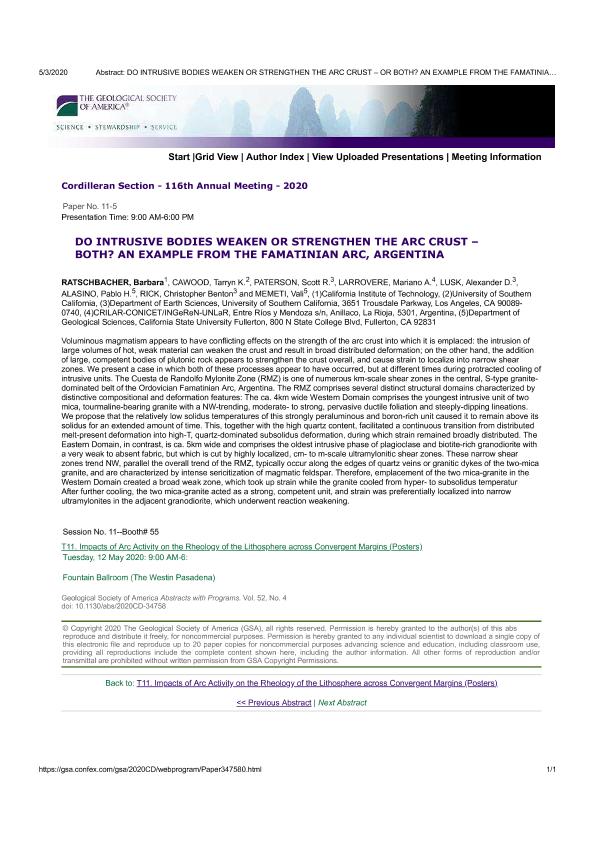Evento
Do intrusive bodies weaken or strengthen the arc crust-or both?: An example from the Famatinian arc, Argentina
Ratschbacher, Barbara; Cawood, Tarryn K.; Paterson, Scott Robert; Larrovere, Mariano Alexis ; Lusk, A.; Alasino, Pablo Horacio
; Lusk, A.; Alasino, Pablo Horacio ; Rick, C.; Memeti, V.
; Rick, C.; Memeti, V.
 ; Lusk, A.; Alasino, Pablo Horacio
; Lusk, A.; Alasino, Pablo Horacio ; Rick, C.; Memeti, V.
; Rick, C.; Memeti, V.
Tipo del evento:
Reunión
Nombre del evento:
116th Annual Meeting of the Cordilleran Section
Fecha del evento:
12/05/2020
Institución Organizadora:
Geological Society of America;
Título del Libro:
116th Annual Meeting of the Cordilleran Section
Editorial:
Geological Society of America
Idioma:
Inglés
Clasificación temática:
Resumen
Voluminous magmatism appears to have conflicting effects on the strength of the arc crust into which it is emplaced: the intrusion of large volumes of hot, weak material can weaken the crust and result in broad distributed deformation; on the other hand, the addition of large, competent bodies of plutonic rock appears to strengthen the crust overall, and cause strain to localize into narrow shear zones. We present a case in which both of these processes appear to have occurred, but at different times during protracted cooling of intrusive units. The Cuesta de Randolfo Mylonite Zone (RMZ) is one of numerous km-scale shear zones in the central, S-type granite-dominated belt of the Ordovician Famatinian Arc, Argentina. The RMZ comprises several distinct structural domains characterized by distinctive compositional and deformation features: The ca. 4km wide Western Domain comprises the youngest intrusive unit of two mica, tourmaline-bearing granite with a NW-trending, moderate- to strong, pervasive ductile foliation and steeply-dipping lineations. We propose that the relatively low solidus temperatures of this strongly peraluminous and boron-rich unit caused it to remain above its solidus for an extended amount of time. This, together with the high quartz content, facilitated a continuous transition from distributed melt-present deformation into high-T, quartz-dominated subsolidus deformation, during which strain remained broadly distributed. The Eastern Domain, in contrast, is ca. 5km wide and comprises the oldest intrusive phase of plagioclase and biotite-rich granodiorite with a very weak to absent fabric, but which is cut by highly localized, cm- to m-scale ultramylonitic shear zones. These narrow shear zones trend NW, parallel the overall trend of the RMZ, typically occur along the edges of quartz veins or granitic dykes of the two-mica granite, and are characterized by intense sericitization of magmatic feldspar. Therefore, emplacement of the two mica-granite in the Western Domain created a broad weak zone, which took up strain while the granite cooled from hyper- to subsolidus temperatures. After further cooling, the two mica-granite acted as a strong, competent unit, and strain was preferentially localized into narrow ultramylonites in the adjacent granodiorite, which underwent reaction weakening.
Palabras clave:
DUCTIL DEFORMATION
,
ARC
,
FAMATINIAN
,
ARGENTINA
Archivos asociados
Licencia
Identificadores
Colecciones
Eventos(CRILAR)
Eventos de CENTRO REGIONAL DE INV. CIENTIFICAS Y TRANSFERENCIA TECNOLOGICA DE ANILLACO
Eventos de CENTRO REGIONAL DE INV. CIENTIFICAS Y TRANSFERENCIA TECNOLOGICA DE ANILLACO
Citación
Do intrusive bodies weaken or strengthen the arc crust-or both?: An example from the Famatinian arc, Argentina; 116th Annual Meeting of the Cordilleran Section; Estados Unidos; 2020; 1-1
Compartir
Altmétricas



